Exploring Amethyst Stones: Significance and Properties
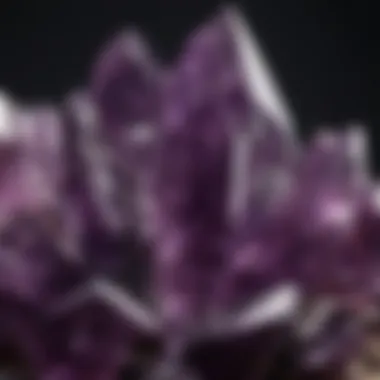
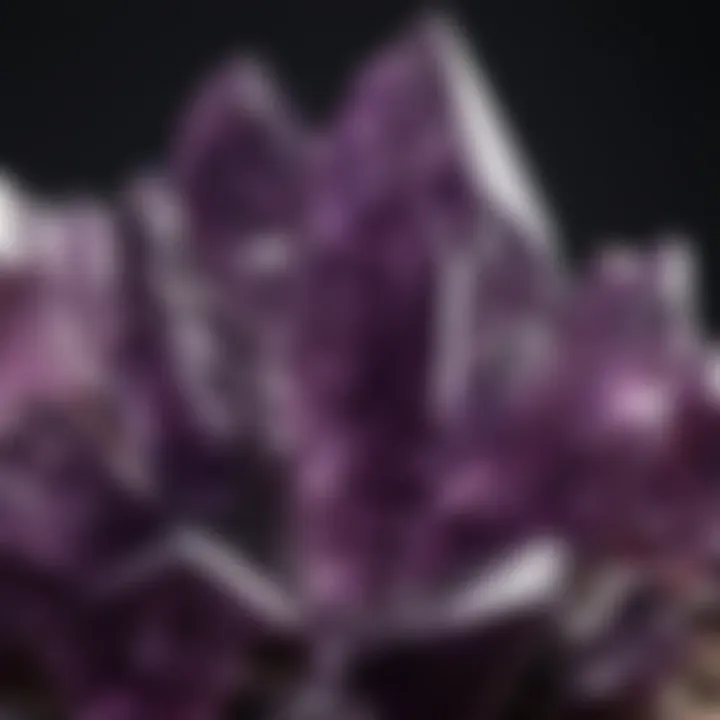
Intro
Amethyst stones are not just beautiful; they are steeped in history and mystique. This deep purple quartz has fascinated people for centuries, captivating gem enthusiasts and casual admirers alike. Understanding the significance and properties of amethyst offers insights not only into the gemstone’s aesthetic value but also into its cultural and historical resonance.
In the sections that follow, we’ll explore amethyst profoundly. From its geological makeup to its role in ancient civilizations, the narrative will weave through various themes that underline the gemstone’s value. This guide will also delve into practical details, including ways to verify authenticity, methods of care, and considerations for market value.
Let’s embark on this enlightening journey through the vibrant world of amethyst stones.
Intro to Amethyst Stones
Amethyst stones, with their rich hues and storied past, have captivated the attention of gem enthusiasts and collectors throughout history. This introduction serves as a gateway to understanding the multifaceted nature of amethyst, exploring its unique properties and significance across various cultures and eras. By diving into the depth of this remarkable gemstone, we uncover not only its geological origins but also its tremendous role in personal and communal practices.
Overview of Amethyst
Amethyst, a type of quartz, is primarily known for its striking purple color, which can range from a light lavender to a deep violet. This captivating color is often a result of iron impurities and exposure to natural radiation. Beyond its aesthetic appeal, amethyst is renowned for its supposed metaphysical properties, where many believe it offers tranquility and heightened intuition. Couplers who work with this stone often tout its balancing power, which finds a home in various spiritual practices.
The significance of amethyst extends to its historical uses, from adornments in ancient royal attire to talismans and protective stones used by spiritual leaders. As societies have evolved, so too has the appreciation for amethyst, transitioning from its role as a symbol of status to a favored choice for jewelry among diverse people today.
Brief History of Amethyst
Historically, amethyst has been linked closely with royalty and the divine. The stone was highly valued by ancient civilizations, including the Egyptians and Greeks. The ancient Egyptians believed that amethyst could ward off evil spirits, and it often adorned the tombs of pharaohs as a symbol of protection and stability. Similarly, the Greeks associated amethyst with Bacchus, their wine god, thinking it could prevent intoxication and promote clear thinking.
During the Middle Ages, amethyst was deemed a stone of the clergy, commonly used in church adornments due to its perceived spiritual value. Bishops wore amethyst rings as a display of their religious authority. In various cultures, amethyst has also been regarded as a healing stone, believed to possess calming properties that could soothe the mind and reduce anxiety.
With time, the popularity of amethyst has transcended borders and epochs, becoming a beloved feature in modern jewelry. Today, amethyst finds its way into not only rings and necklaces but also different forms of art and design, making it a quintessential gem among connoisseurs and casual admirers alike.
Geological Composition
Understanding the geological composition of amethyst stones provides critical insight into both their formation and their unique properties. This knowledge holds vast importance for enthusiasts, collectors, and professionals alike, as it reveals how these stunning gemstones arise from natural processes and the conditions that contribute to their mesmerizing attributes. The structure of amethyst, primarily a variety of quartz, is not just a matter of academic curiosity; it influences aspects such as durability, color, and rarity. Knowing the geological factors that govern amethyst can significantly enhance one's appreciation and valuation of these beautiful stones.
Formation and Geographic Distribution
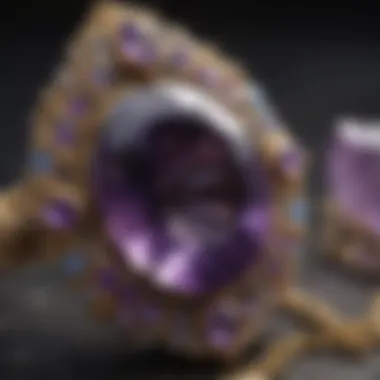
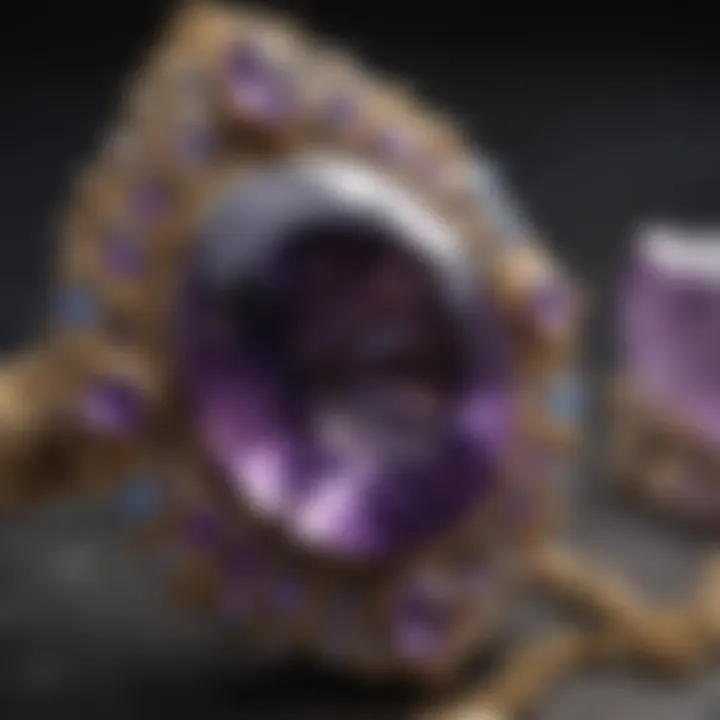
Amethyst forms from a unique combination of geological phenomena that take place over millions of years. Primarily, it originates in volcanic rocks, specifically from the cooling and solidification of lava, which creates cavities known as geodes. Within these voids, mineral-rich solutions seep in over time. As the temperature and pressure change, silica crystallizes, creating the distinctive purple quartz we admire today. Certain trace elements—like iron—undergo oxidation, which is crucial for that exquisite hue.
Geographically, amethyst has a diverse distribution, with notable deposits found in regions like Brazil, Uruguay, and parts of Africa. Brazil stands out as a major supplier, boasting massive amethyst geodes that can weigh hundreds of kilograms. In contrast, Uruguay is famed for producing smaller, yet highly saturated pieces, with an enviable richness in color. Other locations such as Madagascar and the United States (notably Arizona) have also contributed to the global market, each lending its own unique visual character to the stones.
"A gem’s journey from formation to collection tells a story as intricate as its beauty."
Color Variations and Causes
The color of amethyst can range from pale lavender to deep violet, with various shades and intensities that captivate collectors and jewelry designers alike. The primary cause behind these stunning color variations is the presence of iron impurities in the crystal lattice, along with the conditions under which the crystal formed. For instance, stones that develop under certain temperatures and pressures will show deeper hues than those formed under different environmental dynamics.
Interestingly, exposure to radiation—both natural and man-made—plays a role, too. While geological processes typically dictate the color, treatments such as heat can also influence amethyst's hue, either enhancing or changing it entirely.
Some exceptional examples of amethyst boast unique color zoning, where bands of varying shades create a striking visual effect. Not only does this complexity add to the aesthetic appeal, but it also can signify how a particular piece was formed. Collectors often seek out these pieces, recognizing their value as indicators of the amethyst's journey and the geological events that shaped them.
In summary, the geological composition of amethyst stones is not just a scientific detail; it's a gateway into understanding their beauty, value, and place in both nature and culture. As enthusiasts delve deeper into these elements, the stones transform from mere collectibles into stories filled with history and artistry.
Physical and Chemical Properties
Understanding the physical and chemical properties of amethyst stones is crucial for gemstone enthusiasts, collectors, and jewelry designers alike. This section sheds light on what makes amethyst a distinct and revered gemstone. By delving into its hardness and optical attributes, we can appreciate both its beauty and durability. The physical characteristics often play a significant role in determining the stone’s value and suitability for various uses.
Mohs Hardness Scale
The Mohs hardness scale ranges from 1 to 10, assessing materials based on their ability to scratch one another. Amethyst ranks around a 7, making it fairly hard—not as tough as diamond but durable enough for everyday wear. This hardness means that amethyst can withstand daily activities without scratching easily, which is why it’s popular in rings, necklaces, and bracelets.
"The hardness of a gemstone is a key determinant in its suitability for jewelry. Amethyst’s position on the Mohs scale allows it to be a reliable choice for collectors and designers."
Moreover, the hardness of amethyst makes it less likely to chip or break when incorporated into jewelry settings. However, artisans should still handle it with care. Typically, when designing pieces, jewelers often choose protective settings to ensure the longevity of amethyst, especially in rings that face more wear and tear than other types of jewelry.
Furthermore, the hardness gives amethyst a certain heft and feeling of quality. When a piece features solid amethyst, it resonates with the wearer in a way that lighter or softer gemstones may not. Thus, understanding this property can help buyers make more informed choices, ensuring they select pieces that not only captivate visually but also perform well under regular use.
Optical Characteristics
The optical properties of amethyst are another area worth exploring. This gemstone is well-known for its clear, vibrant purple hue, often displaying variations that range from light lavender to deep, rich violet. The coloring comes from iron impurities and radiation exposure during its formation, which gives amethyst its unique look.


When light passes through amethyst, it can exhibit a pleochroism, which refers to its ability to show different colors when viewed from different angles. Depending on the cut, lighting, and placement, an amethyst can appear differently, adding to its charm and allure.
The stone’s transparency also affects how it is perceived; high-quality amethysts are prized for their clarity, as inclusions or cloudiness can detract from their visual appeal. Jewelry designers aim for stones that are as flawless as possible, ensuring that the reflective quality of the amethyst shines through, effectively enhancing the overall look of their creations.
Moreover, the brilliance of amethyst largely depends on its cut. A well-cut stone will exhibit excellent light performance, maximizing its aesthetic appeal. Certain cuts, like the round or oval, can amplify the vibrancy of the color, leading gemstone lovers to weigh the importance of cut when making purchases.
In summary, the physical and chemical properties of amethyst, including its positioning on the Mohs hardness scale and intriguing optical characteristics, form the backbone of what makes this stone so sought after. An appreciation of these elements enables a deeper understanding which can enrich the experiences of collectors and novices alike.
Cultural and Historical Significance
The cultural and historical significance of amethyst stones not only reflects their aesthetic appeal but also underscores their deep-rooted connections to ancient traditions and beliefs. From their use in various ceremonies to being highly prized as symbols of power and spirituality, amethyst has carved out a prominent role across civilizations. This section delves into the roles that amethyst has played throughout human history and its symbolism in various cultures, showcasing how this vibrant purple stone has been more than just a pretty gem.
Historical Uses in Ancient Civilizations
Amethyst is steeped in history, finding its way into the hearts and lives of many ancient civilizations. For the Egyptians, it was believed to protect against evil forces. They used amethyst in jewelry and burial masks, hoping to carry its power into the afterlife. Meanwhile, the Greeks associated this stone with Bacchus, the god of wine. They believed that wearing amethyst could prevent intoxication — a notion that led to its name, derived from the ancient Greek word "amethystos," meaning "not intoxicated."
In ancient Rome, amethyst was also significant, often worn by generals to symbolize valiance and victory. It was embedded in crowns and used in royal regalia, reinforcing its status as a stone of nobility. In the Middle Ages, amethyst beads were sometimes woven into church vestments, symbolizing the purity of spirit and humility. The stone was adored for its association with both power and protection, often thought to have the ability to dispel negativity and bring clarity of mind.
Symbolism in Various Cultures
Amethyst has been revered across numerous cultures for its metaphysical properties and symbolizes various qualities. In many Asian cultures, it is seen as a stone of peace — believed to bring tranquility and calmness to one’s thoughts and emotions. In Buddhism, it signifies spiritual wisdom and is often used in prayer beads, assisting practitioners during meditation.
Furthermore, across Eastern European cultures, amethyst is a powerful talisman against deception and lies. Its purple hue often aligns with royalty and luxury, being associated with wealth and nobility. Many cultures view amethyst as a protective stone that guards its wearer from harm and negative energy.
"Amethyst has woven itself into the fabric of humanity’s history, playing vital roles in various societiesa true gem among gems."
As we explore amethyst’s journey from ancient times to the present, it becomes clear that this captivating stone is not just a beautiful ornament but also a symbol rich with meaning. Whether used in sacred rituals or adorned as treasured jewelry, amethyst continues to resonate deeply within both cultural and historical contexts, marking its significance around the globe.
Amethyst in Modern Jewelry
Amethyst's presence in modern jewelry stands as a testament to its timeless appeal and multifaceted charm. Today, amethyst stones are not only cherished for their aesthetic value but also for their deeper associations with tranquility and balance. Jewelers and consumers alike recognize the ways this striking gemstone can enliven a piece, whether it’s a simple ring or an intricate necklace.
The importance of amethyst in contemporary jewelry lies in its versatility, making it suitable for a wide range of styles and occasions. Its rich purple hue serves as a dramatic accent or a subtle flourish that complements numerous designs. Thus, it can transform a piece without overshadowing other elements, allowing for a unique expression of individuality.

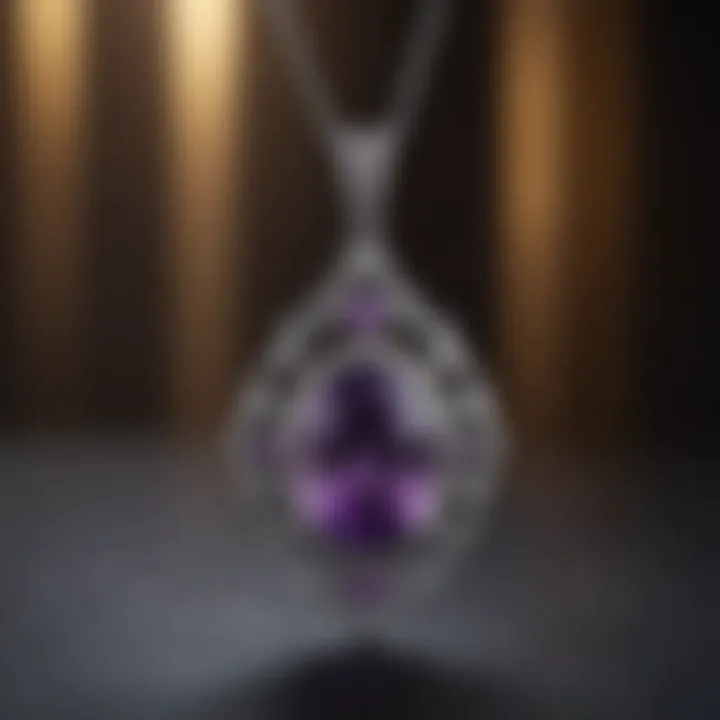
Current Trends in Amethyst Jewelry
Current trends reveal a resurgence of interest in amethyst. Artisan jewelers are honing in on the stone's unique colors and shapes. From deep, royal purples to lighter lavender shades, each variation offers its own personality that adds layers to any creation. Brutalist and vintage-inspired designs are gaining popularity, infusing organic shapes and raw finishes that let the stone shine in its natural state.
Social media platforms like Instagram and visual boards on Pinterest are influencing these trends as well, showcasing the beauty of amethyst in modern settings. Adding to this, there’s been a growing inclination towards sustainable practices in jewelry-making, encouraging the use of ethically sourced amethyst.
"Amethyst remains an expressive choice in jewelry, often seen as an emblem of wisdom and stability."
Design Styles and Settings
When it comes to design styles, amethyst jewelry adapts beautifully to different aesthetics.
- Classic Settings: Traditional solitaires and pavé settings highlight the stone’s brilliance, often paired with diamonds or white gold to enhance its vibrancy.
- Art Deco: Geometric shapes with amethyst inlays provide a sense of vintage prestige, allowing the stone's cut and clarity to take center stage.
- Bohemian: Raw amethyst stones set in bronze or simple metals align perfectly with an eclectic style, appealing to the free-spirited.
Amethyst is not just limited to rings or necklaces; its beauty can also be featured in earrings, bracelets, and even as part of watch designs. Every piece tells a story—whether it's through the choice of metal, the intricacy of the setting, or the personal meaning the wearer brings to it.
As preferences evolve, amethyst remains a significant character in the tale of modern jewelry. Its ability to adapt and transform speaks volumes of its legacy and allure. Whether for personal adornment or as a heartfelt gift, amethyst continues to capture hearts, bridging the gap between tradition and modernity.
Metaphysical Properties
The exploration of amethyst's metaphysical properties opens a door to understanding how these strikingly purple stones have been revered throughout history. This section is particularly significant as it delves deep into the spiritual significance and healing associations attributed to amethyst. It goes beyond mere aesthetics, showcasing how this gemstone has played a crucial role in various cultures and beliefs, particularly among gem enthusiasts and collectors.
Spiritual Associations
Amethyst is often associated with spirituality and higher consciousness. Ancient civilizations believed that this stone promoted clarity of mind and connection to the divine. The Greeks, for instance, named it from the word "amethystos," meaning "not intoxicated," which reflected its purported ability to protect against drunkenness. This connection indicates a belief in its power to facilitate mental clarity and spiritual insight.
Many people believe that amethyst helps in chakra alignment, particularly in activating the crown and third eye chakras. By doing so, it’s said to enhance one’s ability to receive wisdom and guidance from the universe. When you hold or wear an amethyst, its vibration is thought to resonate with the energy of the universe, providing not just comfort but also a protective shield against negative influences.
Healing Uses and Beliefs
Beyond its spiritual connections, amethyst has a longstanding reputation for its healing properties. People have historically harnessed its energy for various ailments. For example, it's believed to aid in alleviating stress and anxiety, making it a favorable choice for those who lead hectic lives. People often place amethyst stones in their living spaces to create a calming atmosphere, helping to bring peace and tranquility.
Some healers employ amethyst in crystal therapy, using it to address physical ailments. Claims suggest that it can assist with headaches, improve sleep quality, and even enhance the immune system. Ritualistic practices often involve placing amethyst under a pillow to encourage soothing dreams or wearing it to alleviate emotional turmoil.
- Key Healing Beliefs associated with Amethyst:
- Stress relief
- Enhanced mental clarity
- Emotional balance
- Support for addiction recovery



